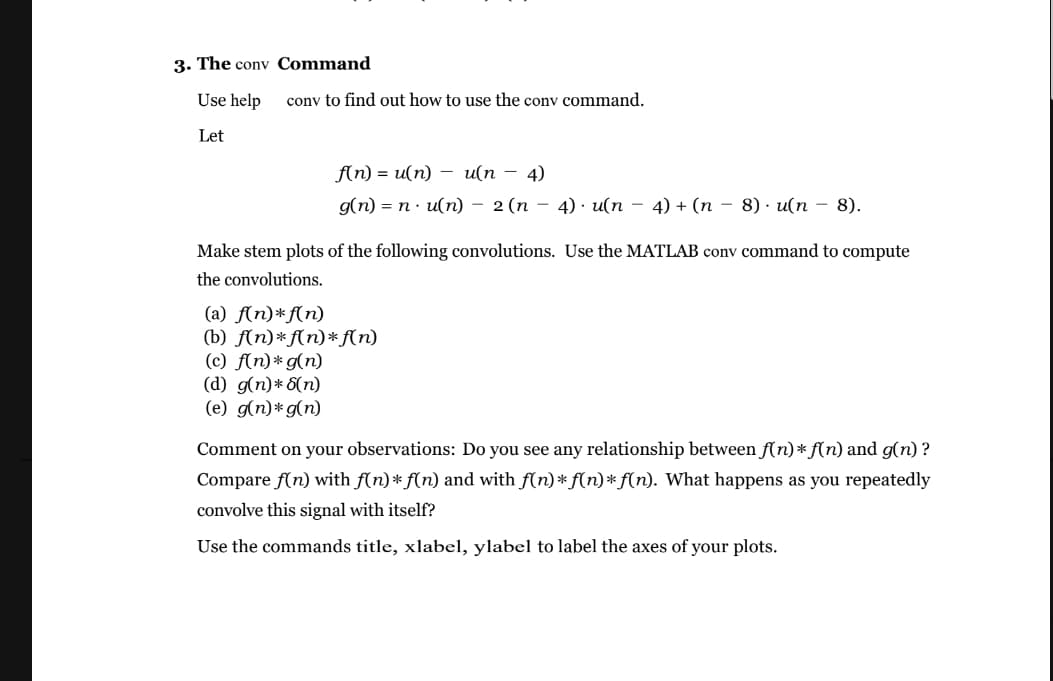e help conv to find out how to use the conv command. f(n) = u(n) – u(n – 4) g(n) = n· u(n) - 2 (n – 4) · u(n – 4) + (n – 8) · u(n %3D ke stem plots of the following convolutions. Use the MATLAB conv command t convolutions. O fn)*f(n) O f(n)*f(n)*f(n)
e help conv to find out how to use the conv command. f(n) = u(n) – u(n – 4) g(n) = n· u(n) - 2 (n – 4) · u(n – 4) + (n – 8) · u(n %3D ke stem plots of the following convolutions. Use the MATLAB conv command t convolutions. O fn)*f(n) O f(n)*f(n)*f(n)
Computer Networking: A Top-Down Approach (7th Edition)
7th Edition
ISBN:9780133594140
Author:James Kurose, Keith Ross
Publisher:James Kurose, Keith Ross
Chapter1: Computer Networks And The Internet
Section: Chapter Questions
Problem R1RQ: What is the difference between a host and an end system? List several different types of end...
Related questions
Question

Transcribed Image Text:3. The conv Command
Use help
conv to find out how to use the conv command.
Let
f(n) 3 и(п) — и(п — 4)
g(n) = n · u(n) – 2(n – 4) · u(n – 4) + (n - 8) · u(n – 8).
Make stem plots of the following convolutions. Use the MATLAB conv command to compute
the convolutions.
(a) f(n)*f(n)
(b) f(n)*f(n)*f(n)
(c) f(n)*g(n)
(d) g(n)* 5(n)
(e) g(n)*g(n)
Comment on your observations: Do you see any relationship between f(n)* f(n) and g(n) ?
Compare f(n) with f(n)* f(n) and with f(n)* f(n)* f(n). What happens as you repeatedly
convolve this signal with itself?
Use the commands title, xlabel, ylabel to label the axes of your plots.
Expert Solution
Step 1
CODE:
n=-10:1:10;
f=heaviside(n)-heaviside(n-4)
g=(n.*heaviside(n))-2.*(n-4).*heaviside(n-4)+(n-8).*heaviside(n-8)
f1=conv(f,f,'same')
f2=conv(f1,f,'same')
f3=conv(f,g,'same')
f4=conv(g,dirac(n),'same')
f5=conv(g,g,'same')
figure; %%relation between f*f and g.
title('relation between f*f and g.')
stem(n,g,'ro');
hold on;
stem(n,f1,'b*');
figure; %%relation between f,f*f and f*f*f.
title('relation between f,f*f and f*f*f.')
stem(n,f,'ro');
hold on;
stem(n,f1,'b*');
hold on;
stem(n,f2,'g^');
Trending now
This is a popular solution!
Step by step
Solved in 3 steps with 2 images

Recommended textbooks for you

Computer Networking: A Top-Down Approach (7th Edi…
Computer Engineering
ISBN:
9780133594140
Author:
James Kurose, Keith Ross
Publisher:
PEARSON

Computer Organization and Design MIPS Edition, Fi…
Computer Engineering
ISBN:
9780124077263
Author:
David A. Patterson, John L. Hennessy
Publisher:
Elsevier Science

Network+ Guide to Networks (MindTap Course List)
Computer Engineering
ISBN:
9781337569330
Author:
Jill West, Tamara Dean, Jean Andrews
Publisher:
Cengage Learning

Computer Networking: A Top-Down Approach (7th Edi…
Computer Engineering
ISBN:
9780133594140
Author:
James Kurose, Keith Ross
Publisher:
PEARSON

Computer Organization and Design MIPS Edition, Fi…
Computer Engineering
ISBN:
9780124077263
Author:
David A. Patterson, John L. Hennessy
Publisher:
Elsevier Science

Network+ Guide to Networks (MindTap Course List)
Computer Engineering
ISBN:
9781337569330
Author:
Jill West, Tamara Dean, Jean Andrews
Publisher:
Cengage Learning

Concepts of Database Management
Computer Engineering
ISBN:
9781337093422
Author:
Joy L. Starks, Philip J. Pratt, Mary Z. Last
Publisher:
Cengage Learning

Prelude to Programming
Computer Engineering
ISBN:
9780133750423
Author:
VENIT, Stewart
Publisher:
Pearson Education

Sc Business Data Communications and Networking, T…
Computer Engineering
ISBN:
9781119368830
Author:
FITZGERALD
Publisher:
WILEY